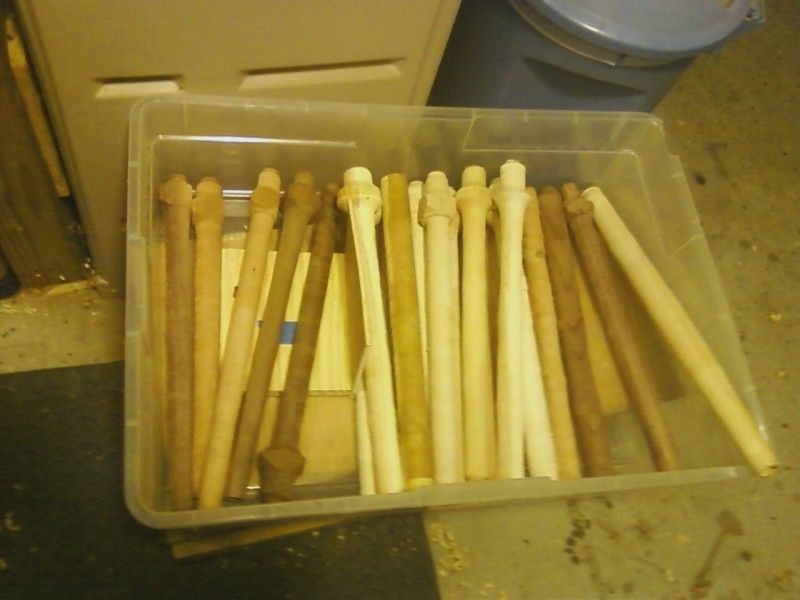Stephen Bacon encouraged me to ask for help with this. He may regret that shortly.
I am determined to get this right. So, I have 20 blanks bored and turned to size or nearly so:

Yes, I am seriously doing it, not asking hypothetical questions. The chunks at one end are waste blocks that keep me from busting tools and knuckles on the chuck. They are bored all the way through. My plan is to work on the head at the other end and cut off the excess to get the bell tone. If length is tight, I can clean up the waste block and use that part of the blank.
They are all bored 14mm cylinders with enough length to be C recorders using the Medieval Recorder instructions from The Woodturner magazine Vol 1 Issue 4. But I intend to make D whistles out of many of them. The C recorder plan calls for OD of about 25mm at the head with a carved curved windway.
Note to moderators - I am going to post a couple of snippets from an article from a now defunct magazine but not full content. please let me know if that isn't allowed and I will remove them.
Anyway, it has a very short section on the windway, fipple and window voicing:
Copyrighted image hidden by staff.
And talks about undercutting in a short bit on tuning:
Copyrighted image hidden by staff.
I have a recorder following directions pretty closely with on major deviation - it is one of those sweetgum blanks and I left it a little thicker. The holes on it got enlarged substantially getting the first octave in tune. It is in tune and sounds okay but a little reedy. The second octave is pretty non-existant. I can make it play the upper octave, but it hisses like a gas leak.
I have a D whistle made of mulberry with the fipple/windway/window pretty faithfully following the instructions and then using flutomat for length and tone holes. It is still a little flat, sounds more like a recorder than a whistle and only has a little of the second octave.
I have a E# maple whistle with an oversized bore, a 5mm x 5mm window and a windway made by boring the entire head larger and then making a fipple with a ramp. It does sound more like a whistle and plays 2 octaves, but the lower octave is mixed in when you play the higher octave.
For other reference, I have a plastic soprano recorder, a wood alto recorder and a cheap metal D whistle.
Other published references I have are Trevor Robinson's Amateur Wind Instrument Maker, Bart Hopkin's Musical Instrument Design and Hopkin's book Making Simple Musical Instruments. The last is just a library book I picked up while there with the kids as I noticed the fipple flute in it is simpler - just a ramp aimed at a crescent cut edge. It also has a couple of simple reed instruments that may be a better introduction than a full fledged clarinet, which I am planning for further out.
I have cutting tools, of course, and I also have an inside digital caliper that can reach from the beak to past the window and give me sub mm accuracy. It claims .1 mm, but I am not sure I hold it level enough for more than .2 accuracy.
I tune with a PC application called mTuner that shows me a history of the tone, graphing it out so I can see it rise and fall showing me the note being played and how many cents sharp or flat.
I am open to suggestions about how to proceed with the tubes. I would like to end up with some decent instruments that I will use to get my feet wet selling at a local craft fair or festival, but I want to learn why certain things are better and not just follow instructions.




